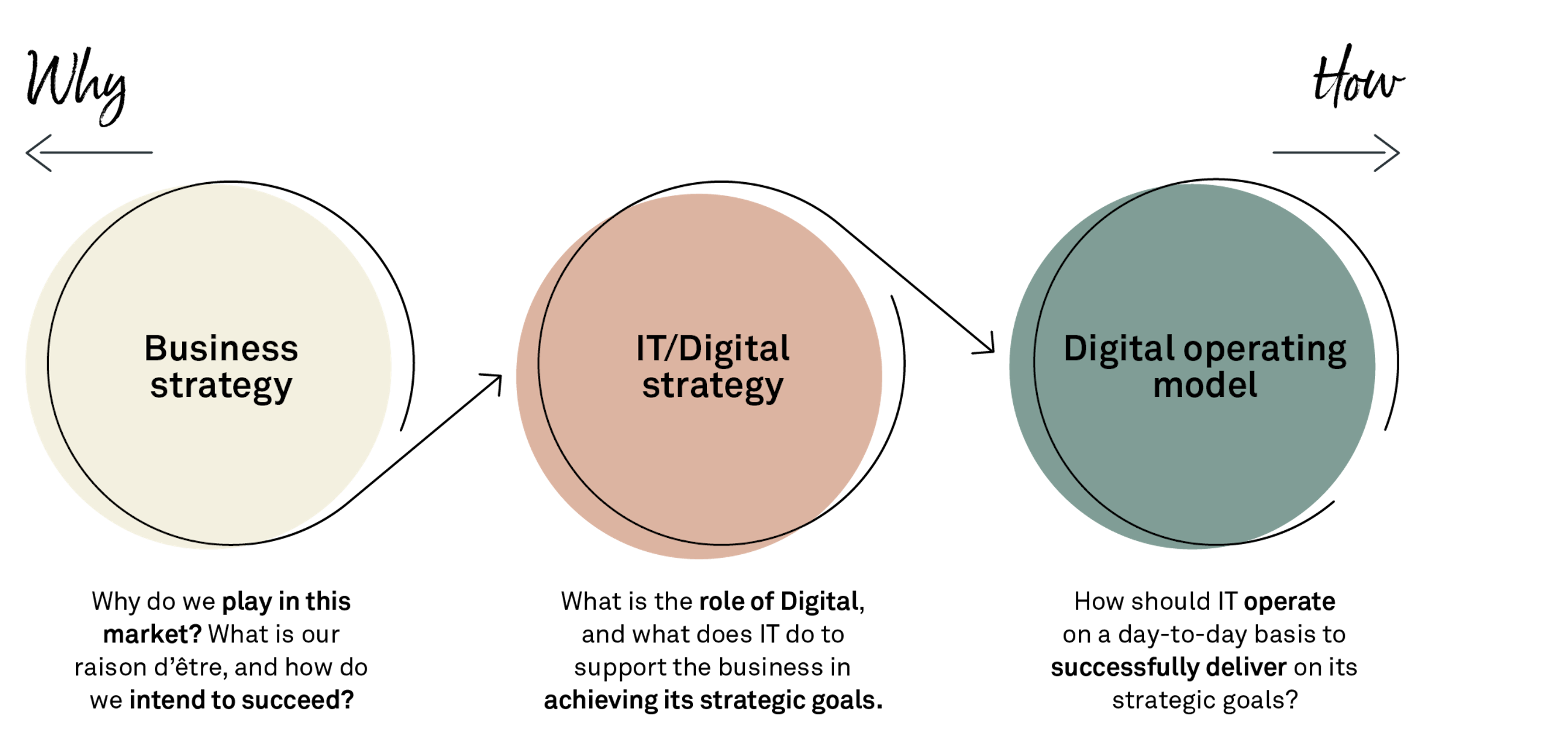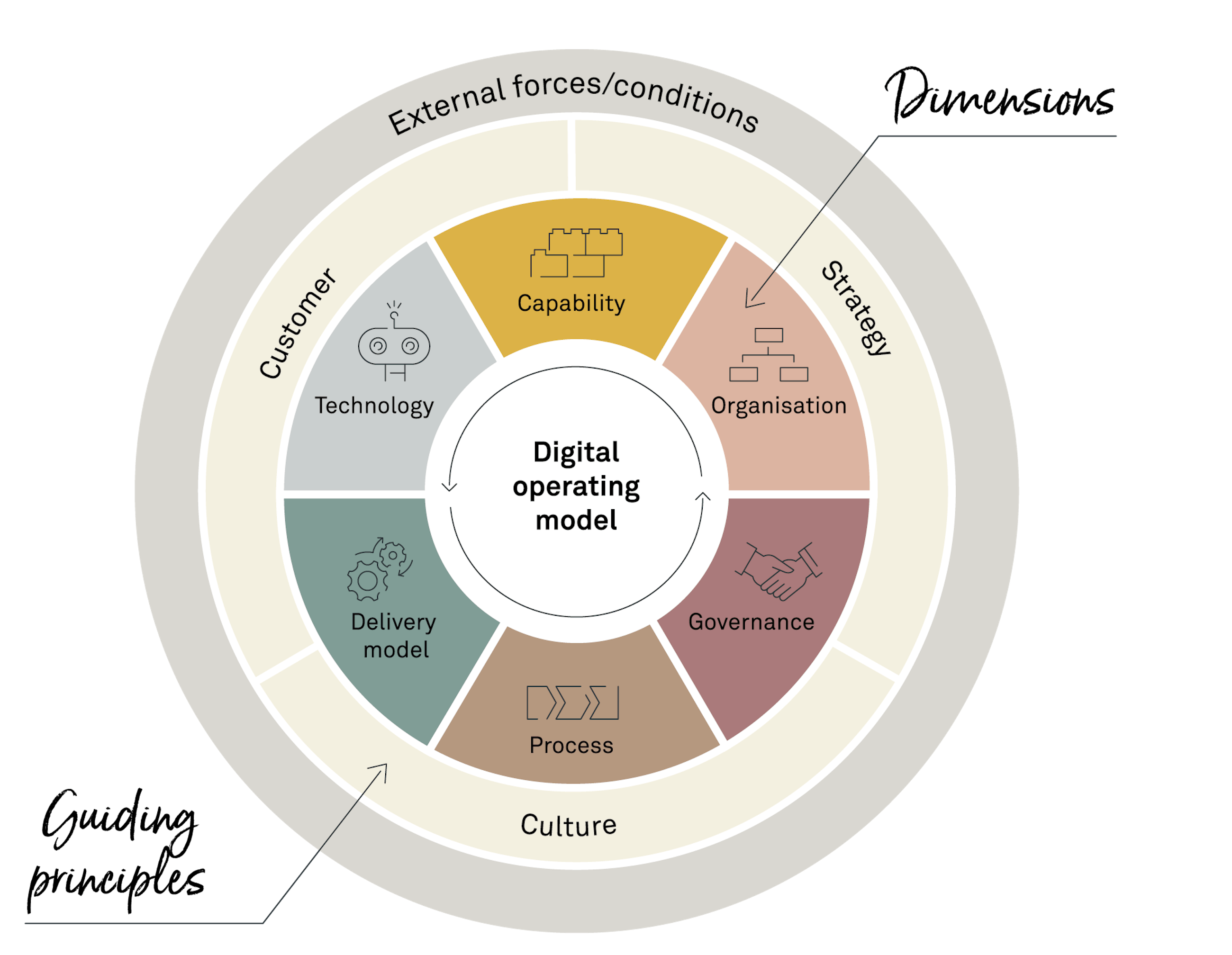How you design a value-oriented digital operating model that maximises business value
2 October 2020
How you design a value-oriented digital operating model that maximises business value
Designing a digital operating model in an ever more complex world
The change driven by digitalisation is happening faster than ever before. The impact of digitalisation is blurring industry boundaries, creating new industry ecosystems and changing market dynamics across almost every industry. In addition, externalities such as a global pandemic increase uncertainty and drive the need for radical change that spans outside the control of any organisation. This results in even more dynamic business environments, and even though the long-term business objectives are the same, the course of action has changed. It has never been more complex yet critical than right now to design and continuously nurture an IT operating engine that enables your business to leverage technology and digitally enabled capabilities to innovate and realise its objective.
The importance of a well-designed digital operating model is increasing as technology becomes further integrated into the business and thus becomes essential for the business to realise its strategy and to remain cost competitive in the marketplace whilst continuously innovating its products and services and delivering high-quality customer experiences.
It is highly complex for the IT and digital organisation to fulfil its role and enable the business to deliver because the digital operating model is under constant pressure to change. This is driven by e.g. new technologies, new vendors being introduced in parallel with constant changing business demands and need for swift adjustments, and the complexity is further fuelled by an endless focus to drive down IT-related costs.
"The digital operating model serves as the link between the digital strategy, people and the technologies that are put in place to ensure effective execution and alignment with the strategy."
Due to the rising complexity of the technology landscape, it is becoming increasingly challenging to design the optimal digital operating model. As changes are introduced in one place, there are oftentimes dependencies on other dimensions in the digital operating model, which are left untouched as the dependency is not clear. This leaves many organisations with IT operating models that are not fully in sync or optimised and thus with increased and uncontrolled costs, slow time-to-market process for new services and a general potential to deliver higher value to the business.
The task of refining and managing the digital operating model may seem overwhelming. But you can follow a framework that enables you to approach the exercise holistically and ensure that dependencies are fully understood. This can help organisations to proactively adapt and improve the value from IT on an ongoing basis.
Benefits of a well-crafted digital operating model
A well-designed and organisationally anchored digital operating model is the foundation for digitalising your business and driving increased value from technology and automation. It provides the blueprint for how you organise processes and teams, how you utilise technologies and what digital services you should develop and deliver to create value for the organisation.
We experience that companies with a well-crafted digital operating model stand out in five decisive areas:
Strong strategy and execution alignment
A balanced digital operating model bridges strategy and execution, helping the organisation to focus on the right objectives, priorities, activities and tasks while encouraging the behaviour needed to support realisation of strategic ambitions.
Operational efficiency
Aligning the digital agenda with a standardised way of working ensures that the effort is focused on value-adding activities and elimination of redundancies. Cost can be better managed given the common understanding of the “jobs to be done”, and agility can be achieved.
Better process integration and productive collaboration
Standardised IT processes and procedures with clear overview of roles, responsibilities and accountabilities enable better collaboration and knowledge sharing across functional areas and teams. This also benefits system and data integration as the defined standards make it clearer how the processes are linked together across the organisation, hereby killing complexity.
Effective decision-making
With clearly defined procedures and processes for technology-related decision-making across the organisation, a common understanding and acceptance of leadership and management are better supported, which can lead to better execution of decisions.
Improved risk and complexity management
Challenges and risks can be identified, handled and mitigated earlier due to clear guidelines on how technology is managed and operated based on alignment with common standards and regulatory requirements.
Designing a digital operating model can be complex – it is like solving the Rubik’s Cube
IT and business development continue to become further integrated as processes, applications and technologies get increasingly entangled in delivering customer-facing services and products. For this reason, digital leaders must approach their operating model with a holistic view, taking into consideration both an outside-in view, i.e. the context and ecosystem the organisation is part of (e.g. customers, corporate strategy, market trends etc.), and an inside-out view, i.e. capabilities and maturity of the organisation, IT budget, legacy stack and state of the organisation’s IT landscape.
Hence, you must consider all aspects of the digital agenda when you develop your digital operating model, and it is key to figure out what is critical to deliver and how to best put the different pieces together in a meaningful pattern. Just like a Rubik’s Cube.
"Developing a digital operating model is like solving the rubik’s cube – the aim is to get the different pieces in it to fit together."
However, the challenge is that there are interdependencies between the different pieces (i.e. areas within IT and digital), meaning that a change in one area will require modification in other areas. It is like the cogwheels that are designed to fit perfectly together to get the car engine running or the watch ticking. If one of these fails or is modified, it will impact the rest of the mechanics. These interdependencies are the ones making the exercise of designing a new digital operating model complex.
At Implement, we believe that a winning digital operating model should be value-oriented and holistically designed to cover both IT and digital functions, and we thus define the digital operating model as the framework the organisation follows to successfully run, optimise and transform the business and deliver on its digital value proposition.
The framework bridges strategy and execution by:
- Providing an integrated view of how the digital organisation interfaces with the business, what key digital services are delivered and how they are delivered.
- Providing a holistic description of the IT and digital functions as well as the processes and frameworks used to execute.
- Describing how people, technology and other capabilities are combined to maximise business value.
- Providing answers to which services and capabilities to outsource and what to keep in house.
In other words, while the IT and digital strategy answers the what and the why in the context of the business strategy, the digital operating model answers the how in the context of the IT and digital strategy, i.e. how the IT and digital organisation should operate on a day-to-day basis to successfully deliver on its strategic goals. It helps digital leaders to cut through the “noise” and to focus on what is critical and what provides value to the business.
A holistic framework used to analyse, adjust and design a value-oriented digital operating model
The framework consists of three guiding principles and six dimensions which combined make up the holistic and value-oriented digital operating model.
The guiding principles
Outside the organisation, i.e. the environment in which the business operates, changes are constantly undergoing, driven by competition, emerging technologies, legislation etc., and this evidently impacts the strategic choices within both business and IT. As the organisation adapts to and aligns with these external forces and conditions, the digital operating model needs to be aligned with these changes. Therefore, you do not design a digital operating model as a one-off exercise. Rather, you need to keep it alive. You must approach it with agility and an adaptable mindset on an ongoing basis to ensure that IT stays fit for purpose.
Surrounding the digital organisation is the overall business context, which covers three elements that need to be factored in when you design your digital operating model:
- The strategy the organisation aims to realise.
- The customers the business serves.
- The culture of the organisation.
Collectively, they provide the direction for your digital operating model. Thus, they work as guiding principles that help define a set of key objectives and principles for designing or adjusting your operating model to ensure that it is fit for purpose.
The dimensions of the digital operating model
The six dimensions are the essence of the model as they are changeable and in the control of the IT and digital leadership, and they must be designed to fit together. As mentioned, significant changes to one dimension may require alterations to other dimensions, which is also why you must approach the exercise in a balanced manner.
Capability
The capability dimension specifies which IT and digital competencies at a strategic level the organisation must develop or acquire and at what capacity to be able to deliver the specified services at the agreed service levels. It carefully identifies which capabilities are strategic to the organisation and should be invested in and which capabilities are commodities and should be delivered at low cost.
Organisation
The organisation dimension reflects the division of tasks and responsibilities between functions and roles and sets the span of control of managers. It requires organisational design, which includes evaluating various options such as whether digital functions should be functionally aligned, whether to adopt Spotify or SAFe organisational designs or whether to organise towards the business units. Furthermore, it focuses on detailing the roles and FTE dimensioning required to support the organisation.
Governance
The governance dimension enables transparent and accountable decision-making through clear mandates and procedures and defines the level of centralisation and key governing elements for tech-related decisions. It provides the structure and control of IT and digital investments and the decision rights in the IT and digital development cycle across the different domains, e.g. who approves solution designs and governs the enforcement of security standards.
Process
The process dimension clarifies how tasks are carried out (in flows) and how services are delivered. This includes selecting and tailoring processes from best practice frameworks such as ITIL and Agile. The process identifies leading practice in the organisation and definition of standard, tool usage and selection of templates, e.g. designing a process framework that can cater for both traditional and agile project delivery.
Delivery model
The delivery dimension defines the optimal split of in- and outsourcing and identifies which services to source from where. The delivery model aligns the strategic objectives with the capability assessment and considers how to best enable the organisation to deliver the IT and digital services with an optimal level of total cost of ownership.
Technology
The technology dimension defines the types of technologies to enable the organisation, e.g. the usage of cloud and transition from legacy. It provides the direction and priorities for modernising the IT and digital landscape and evaluates and identifies the technologies with the most potential for the business to invest in.
How to get started with the design of a value-oriented digital operating model
If you want to be able to create value fast, start with the why and implement a hypothesis-driven approach with selected deep dives into the specific dimensions that you think create the most impact for your organisation if they are redesigned and realigned.
Apply this approach and conduct the following steps:
- Define the why for the transformation of the digital operating model.
- Understand weaknesses and frictions in current operating model.
- Establish design principles that are deeply anchored in the overall aspiration of the transformation.
- Design, test and evaluate options before making choices.
- Carefully manage the change in the organisation and across potential vendors.
- Monitor performance of changes and proactively react if benefits are not realised and enable a feedback loop for further optimisation.
Lastly, you must ensure broad involvement of relevant leaders and specialists in the organisation to capture the essence of current frictions and to test ideas and potential solutions.
Is your digital operating model fit for purpose?
IT and digital leaders must take their time to reflect on the fit and performance of their current setup.
To assess the state of your operating model, you can do a brief reality check by reflecting on the following questions:
10 key questions to help you to assess if your digital operating model is fit for purpose
- Have you defined the critical capabilities for your digital organisation to develop to deliver on your strategy today and in the future?
- Is your digital organisation designed (e.g. Spotify, functionally aligned, cross-functional teams) in a way that best caters for the needs the business has for IT and digital services?
- Do you strike the right balance between self-steering teams and control-based decision-making with regard to IT across your organisation?
- Have you defined a process that efficiently enables you to work with waterfall and agile approaches depending on the characteristics of the project at hand?
- Have you strategically adopted cloud in your IT delivery model and developed your competencies to manage this?
- Do you know the performance and technological state of your business-critical applications?
- Is your IT and digital strategy fully aligned with the business strategy and priorities?
- Do you know which new services will be relevant to your business customers and what tools and platforms they expect you to deliver?
- Is your culture adaptable in terms of experimentation, and do your people dare to fail in digital and IT projects?
- Do you know which trends are emerging and which technologies are gaining ground in your industry?





